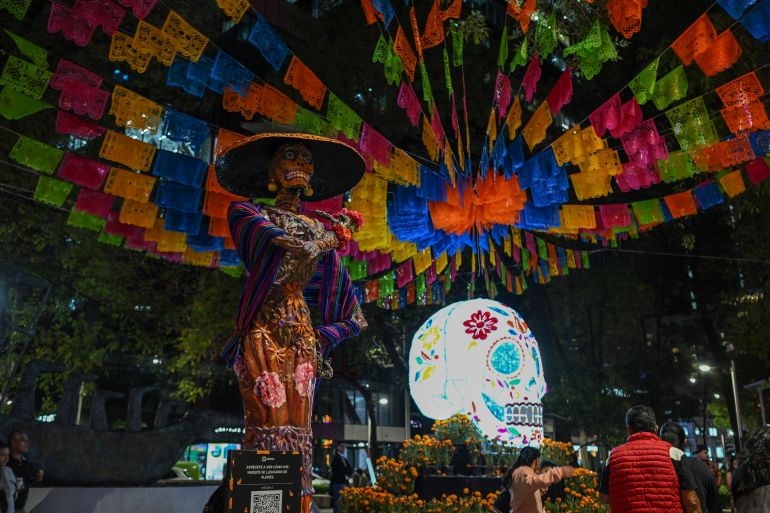Five things you should know about Mexico’s Day of the Dead
Between skulls and marigold flowers, here is the significance of the Day of the Dead.

Published On 31 Oct 202531 Oct 2025
Save
This week, houses and streets in Mexico have been decorated with colourful altars, marigold flowers, candles and sugar skulls.
This is because Mexicans are gearing up to celebrate El Dia de los Muertos – the Day of the Dead – the country’s most important fiesta, which begins this weekend.
Mexican families will gather in homes and cemeteries in memory of their family members who have departed. The day is packed with lively parades and rituals such as the decoration of altars, and sumptuous victuals including Mexican street food, a special kind of bread and hot chocolate.
It’s a celebration of life, not death
The Day of the Dead, or El Dia de los Muertos, is not for mourning or grieving, but for celebrating the lives of those who have passed.
It is believed to be a time when the living and dead can connect with each other. Traditional practices, such as placing marigold flowers on altars and offering certain food items, the aroma and colour of which are thought to help spirits return to visit the living.
To commemorate the dead, people also dress up in colourful skeleton costumes.

The Day of the Dead has Indigenous roots
The festival is rooted in the ancient Aztec belief that death is a continuation of life. Descendants of the Aztec people exist to this day, primarily in Mexico.
Advertisement
The Aztecs, who were native to central Mexico from the 14th to the 16th century, celebrated the deceased with monthlong festivities.
They also honoured the goddess of the underworld, Mictecacihuatl, and made offerings of food from the harvest and personal belongings to her during these festivals.
When Spanish colonists arrived in Mexico from 1519, they imposed Catholicism on the Aztecs and combined these festivities with Catholic holidays – All Saints’ Day on November 1 and All Souls’ Day on November 2.
Eventually, these two days merged into the Day of the Dead.
Families create altars for the deceased
Families create altars called “ofrendas” in their homes and in cemeteries, laden with offerings to deceased loved ones and ancestors.
Altars are created with two levels to symbolise heaven and Earth, three levels to include purgatory, or seven levels to signify the steps to reach heaven.
Items representing the four elements are also placed on the altars: water to quench visitors’ thirst; fire in candles to guide the spirits; earth, represented by food and special items for the deceased; and air, represented by colourful paper designs. Some altars also include salt, which is believed to aid souls on their journey in the afterlife.
These altars also display pictures of the deceased, items of their favourite food, candles and marigold flowers, which are believed to help lead spirits back from the cemetery to their family’s homes.

The altars also include tongue-in-cheek poems dedicated to the deceased loved ones called “calaveras” (skulls). These poems describe interesting habits and funny stories which took place during the lives of the now deceased.
Skulls, which represent the cyclical nature of life and death, are a pervasive symbol during the Day of the Dead. Sugar skulls, or “calavera de azucar” are edible and decorative skull models made with sugar, clay or papier-mache, are used to adorn altars.

Another common food item during the festival is the “bread of the dead” – “pan de muerto” – a circular loaf of bread with bone-shaped designs. The bread is typically sugar-coated, representing the tears of sorrow shed by loved ones.
Advertisement
The bread is baked and eaten on both days of the festival, and is also offered at the altars.
Websites such as MiAltar also allow users to create virtual altars. These can be shared on the website.
La Catrina dominates parades
La Catrina is a tall, female skeletal figure, and she is seen everywhere during the festival.
She was a character created in the early 1900s by political cartoonist and lithographer Jose Guadalupe Posada.

La Catrina dons a fancy French hat and feathers. Posada’s work was a commentary on the aspirations of Mexicans to emulate the European elite.
Posada was known for saying “we are all skeletons”, alluding to how, under the luxurious clothing, jewellery and coverings, we are all the same.
In 1947, artist Diego Rivera included Posada’s art in a mural, naming her Catrina, which means “the rich”.

Day of the Dead continues for more than one day
The main days of celebration are November 1 and November 2. However, some parts of the world begin celebrations on October 27, when people also commemorate their dead pets. The days following this are dedicated to building altars.
While the Day of the Dead is a Mexican festival, it is also celebrated across Latin America, in Spain, some parts of the United States with large Mexican-American populations, and the Philippines, which was colonised by Spain in 1565.
November 1 is typically dedicated to children who have passed, referred to as “angelitos” (little angels). Their graves are decorated with toys and balloons.
The day after, also still called All Souls Day, is for adults who have departed.
